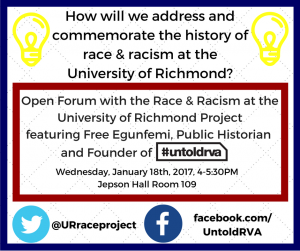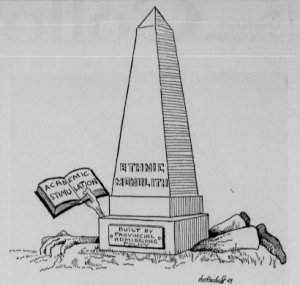This week on Expanding the Ivory Tower we explore the celebration of Black History Week at the University back in 1974. In this episode we consider the historical context of the event and the struggle to make it happen.
Uncategorized
Potent and Divisive
In his final address to the nation, President Obama outlined the most imminent threats to our democracy – one of which he described as “as old as our nation itself.” He admonished the dream of a post-racial America many envisioned after his election as unrealistic. According to him, the threat of “race remains a potent and often divisive force in our society.” However, more accurately stated, he should have said racism remains a potent and often divisive force in our nation, but he didn’t. Why?
Racism is a taboo word in the public sphere. Terms like race and race relations have become euphemistic ways to talk about racism. This linguistic elision has made it so people believe talking about race is difficult and that discussing the socially constructed identifiers ascribed to different groups of people is cringe worthy and uncomfortable. In reality, talking about race is easy. When taken to be a socially constructed system of identification based on factors such as physical traits and ancestry, race is not that big of a deal. Through that lens, race is just something we all have, like a favorite sports team, or something we can all relate to, like being from a certain state.
By now you may be shaking your head and thinking to yourself that talking about being an Eagles fan or from Oklahoma is certainly a lot easier than talking about being black in America and you’re right. It is. That is because when talking about being black in America the conversation that follows is not simply about race. The conversation is also about racism. Racism is like race’s evil twin brother that lurks in the shadows, seeps through the cracks, and permeates nearly every facet of American society. Racism involves the unequal distribution of resources, unbalanced power dynamics, and unfettered privilege afforded to some based upon the system of identification that is race. While the two are closely related they are not the same but since they are so interconnected conversations that involve racism are often mistaken for conversations that are just about race.
President Obama engaged in the sort of rhetorical fodder that neglects to call racism by its name. On such a basic level he failed to get real about the reality of race and racism in America. To refer to race as a potent, divisive force in society and to not speak the word racism except when qualified by the word reverse, Obama inadvertently contributed to the very threat he warned against.
Open Forum with the Race and Racism at the University of Richmond Project
Join the Race & Racism at the University of Richmond Project on Wednesday, January 18 from 4-5:30 PM in Jepson Hall Room 109 in an Open Forum to discuss the project’s partnership with Free Egunfemi, founder of Untold RVA. Untold RVA’s pod marker project seeks to connect individuals with sites of self-determined history throughout the city, honoring Richmond’s abolitionists, women’s rights activists, creative change agents, and more. The Race & Racism Project’s partnership with Untold RVA seeks to bring the pod marker project to our campus in order to make the history of resistance and change more visible and spark continued conversation and action for an equitable and inclusive community.
This Open Forum seeks to begin a conversation about campus history and current events to create pod markers that will be visible to all members of the UR community and visitors. No knowledge of UR history is necessary to attend, as the forum seeks to gain feedback and create a dialogue about who, what, and how commemoration will work. We will also speak about opportunities for collaboration with Untold RVA via independent studies and summer fellowships as the Richmond-centered project expands.
The Unfinished Work
This week our Post-Baccalaureate fellow, Victoria Charles, takes to the studio to reflect on the memory of Dr. Martin Luther King. More specifically, she dives into how Dr. King is remembered here at the University of Richmond. To do so, Victoria spoke with Lisa Miles, associate director of Common Ground and member of UR’s MLK Day planning committee, about how the University commemorates King today.
This Week in the Archive: A Year Of Accomplishment
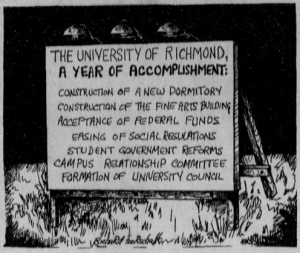 The end of a year, whether that be calendar or academic, is often framed as cause for reflection. Yet end-of-the-year roundups do more than just look back. They consider the defining events of the year through the lens of whoever is writing. Those musings say as much about the events of the year as they do the positionality of the writer. When we take a look at what is included and more importantly what is left out we can unearth valuable subtext. Opportunely, this method applies to archival work as well. Take for example this cartoon published in The Collegian on May 17, 1968. The image depicts signage that reads “The University of Richmond, A Year of Accomplishment”. The cartoonist chose to frame what he deemed the most significant events of the academic year as accomplishments. The claim to accomplishments begs the question, accomplishments for whom? If we take a closer look at the first three: the construction of a new dormitory, the construction of the fine arts building, and the acceptance of federal funds, the answer to that question becomes complex.
The end of a year, whether that be calendar or academic, is often framed as cause for reflection. Yet end-of-the-year roundups do more than just look back. They consider the defining events of the year through the lens of whoever is writing. Those musings say as much about the events of the year as they do the positionality of the writer. When we take a look at what is included and more importantly what is left out we can unearth valuable subtext. Opportunely, this method applies to archival work as well. Take for example this cartoon published in The Collegian on May 17, 1968. The image depicts signage that reads “The University of Richmond, A Year of Accomplishment”. The cartoonist chose to frame what he deemed the most significant events of the academic year as accomplishments. The claim to accomplishments begs the question, accomplishments for whom? If we take a closer look at the first three: the construction of a new dormitory, the construction of the fine arts building, and the acceptance of federal funds, the answer to that question becomes complex.
The construction of the new dormitory was important because some students had been living in temporary barracks that were pre-war, hazardous, and prone to fire. However, this new housing option was only available to male students despite the fact that female students were also in need of improved housing. In fact, an editorial published in the same Collegian issue as this cartoon lamented the overcrowding and lack of amenities available in one of the main residence halls for women. The construction of the fine arts building symbolized a triumph of fundraising and dedication to the advancement of the arts at the University. The construction of the building also underscored the problem of the University paying its workers too little. In fact, work on the building was halted by a worker’s strike started by laborers at the heating plant. Electricians working in the fine arts building participated in the strike as a sign of solidarity with the heating plant workers. The strike eventually ended but did not result in higher wages for the workers. The acceptance of federal funds meant that more money would be available for use other than capital construction but also meant that the University had to comply with federal statutes such as the Civil Rights Act of 1964, which prohibited discrimination on the basis of race, color, or national origin in any program receiving federal funds. Despite having integrated downtown night courses in 1964, the University of Richmond remained segregated on its main campus until the fall of 1968, months after this cartoon was published.
The cartoonist chose to portray the year as one of progress without acknowledging the tenuous nature of the accomplishments he highlighted. He failed to consider that what was good for some was, in fact, harmful to others, that his purview of accomplishments and progress existed in a space where black students had not yet been welcome.
Remembering the Forgotten
Another group of students from Dr. Maurantonio’s “Digital Memory and the Archive” course chose to use the podcast form to engage with the University’s history of race and racism. Bal Artis, Tenaya Bien, and Megan Wirtz explored challenges in archival research when inquiring into the lives of black staff members at the University of Richmond between 1946 and 1971 in their podcast Remembering the Forgotten.
Freeman Digitally Remastered
As part of inquiries into the University of Richmond’s history of race and racism, students from Dr. Maurantonio’s “Digital Memory and the Archive” class have grappled with varying ways of narrating history. Natalia Chaney, Maddy Dunbar, and Canyon Teague explored contemporary understandings of Douglas Southall Freeman and considered the relationship between building names and University values in their podcast Freeman Digitally Remastered.
This Week in the Archive: The “Ethnic Monolith”
This cartoon accompanied an editorial published on October 17, 1969, concerning academic life at the university. The editorial was part of a series from The Collegian that analyzed the results of the President’s Committee to Study Campus Relationships. The push for the study came from an earlier series of editorials published in 1968, which argued that distrust between the administration, faculty, and students fostered a negative environment at the school. Following the recommendation of the editorial series, President Modlin appointed a committee, comprised of both faculty and students, to study the problem in 1968. Modlin’s steadfast response to the students in the form of a committee cannot be considered outside of the context of what was going on around the United States at the time. In 1968 cities across the United States were engulfed in flames and rioting in response to Martin Luther King’s assassination, college campuses were sites of disruptive protests against the Vietnam War and the resulting draft, and even here in Virginia, the fight for integrated public schools was still being waged. While it is possible the Modlin simply acted out of goodwill and concern for students it is equally possible that he just wanted to keep the peace on campus by any means necessary. By allowing the study to happen but not actually do anything about it Modlin gave the appearance of a commitment to progress without actually being committed to progress.
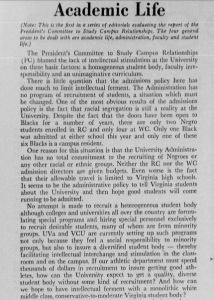 In part, the report from the study attributed low morale on campus to a lack of intellectual stimulation, which was reportedly caused by three factors: a homogenous student body, faculty irresponsibility, and unimaginative curriculum. The cartoon depicts the concern about homogeneity in the student body with a statue engraved with the words “ethnic monolith.” Said statue also carries an inscription that reads “built by provincial admissions policy”, which points to the fact that little money was dedicated to academic recruiting and little recruiting was done outside of Virginia at the time. According to the editorialist, the lack of diversity at the university was intellectually stifling. While I do see the merit of this piece in urging for diversity, the editorialist’s argument is very self-serving. In this appeal for more diversity, especially in regards to black students, there is little discussion of championing civil rights or combatting injustice. This editorial frames integration as good for white students and not necessarily a remedy for the injustices suffered by students from other groups. On a surface level what seems like an altruistic plea for integration is actually harmfully myopic. Instead of proposing to create an environment conducive to the success of students from different backgrounds the assumption is that simply having them at the university will make things better. Although well meaning, the argument in the editorial and the accompanying cartoon is negligent and misguided at best.
In part, the report from the study attributed low morale on campus to a lack of intellectual stimulation, which was reportedly caused by three factors: a homogenous student body, faculty irresponsibility, and unimaginative curriculum. The cartoon depicts the concern about homogeneity in the student body with a statue engraved with the words “ethnic monolith.” Said statue also carries an inscription that reads “built by provincial admissions policy”, which points to the fact that little money was dedicated to academic recruiting and little recruiting was done outside of Virginia at the time. According to the editorialist, the lack of diversity at the university was intellectually stifling. While I do see the merit of this piece in urging for diversity, the editorialist’s argument is very self-serving. In this appeal for more diversity, especially in regards to black students, there is little discussion of championing civil rights or combatting injustice. This editorial frames integration as good for white students and not necessarily a remedy for the injustices suffered by students from other groups. On a surface level what seems like an altruistic plea for integration is actually harmfully myopic. Instead of proposing to create an environment conducive to the success of students from different backgrounds the assumption is that simply having them at the university will make things better. Although well meaning, the argument in the editorial and the accompanying cartoon is negligent and misguided at best.
Reexamining the Narrative
This week on Expanding the Ivory Tower Victoria critiques her own work and the practice of examining black students’ experiences through the lens of racism. Using the post about Walter Carpenter as a jumping off point, she unpacks the tension between acknowledging racism in the archive and centering racism in archival narratives.
This Week in the Archive: The Case of Walter Carpenter
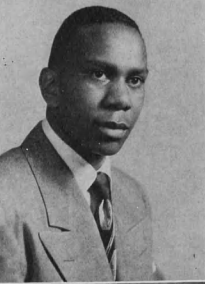 On June 8,1964 Walter Carpenter became the first African-American to receive a degree from the University of Richmond through the institution’s University College division. This overlooked historic occurrence predates the passage of the Civil Rights Act of 1964 and the arrival of Barry Greene (the first black undergraduate student) on campus in 1968. Yet I would urge caution against identifying this milestone as an indication of progressiveness on the part of the university. Instead, Walter Carpenter’s story underscores the cumbersomeness of the university’s segregation policy.
On June 8,1964 Walter Carpenter became the first African-American to receive a degree from the University of Richmond through the institution’s University College division. This overlooked historic occurrence predates the passage of the Civil Rights Act of 1964 and the arrival of Barry Greene (the first black undergraduate student) on campus in 1968. Yet I would urge caution against identifying this milestone as an indication of progressiveness on the part of the university. Instead, Walter Carpenter’s story underscores the cumbersomeness of the university’s segregation policy.
When Carpenter began taking a graduate class sponsored by the university at Ft. Lee, University of Richmond administrators did not revoke their pro-segregationist stance. Ft. Lee, a military post in Virginia, and the rest of the armed forces formally integrated in 1948 under Executive Order 9981. Since the class was being held at Ft. Lee it is presumed that the university did not have jurisdiction over who was allowed to enroll. Although Carpenter was a civilian employee, he benefitted from desegregation at Ft. Lee. For an unknown reason, Carpenter’s class was eventually shifted to University College, the University of Richmond’s downtown division, in 1962. At its semi-annual meeting in February of 1963, the university’s Board of Trustees reaffirmed the school’s policy of racial segregation but opened certain graduate and professional classes to black students. To the uncritical eye, it would seem that the university took a meaningful step toward openness and integration but in actuality, the university simply forged a very narrow path to progress in one place and double downed its segregation efforts everywhere else, which made for a deceptively open yet still very racist admissions policy.
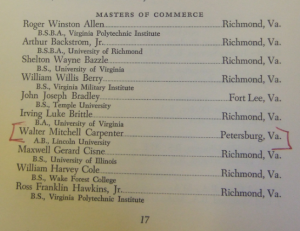 In February of 1964, the university issued a statement announcing classes sponsored by the American Institute of Banking were open to black people and that 12 or more had been enrolled in classes. The Collegian article reporting this decision made no mention of Carpenter, whose course of study was not part of the American Institute of Banking. In fact, Carpenter had completed his degree requirements for the masters of commerce before the university issued the statement. The university’s statement only slightly widened the path to integration because it just opened courses sponsored by one entity. At this point University College was not completely integrated; only certain courses were, including the ones sponsored by the American Institute of Banking. Again it seems that the university was trying to give the illusion of an open admissions policy while still being pro-segregation.
In February of 1964, the university issued a statement announcing classes sponsored by the American Institute of Banking were open to black people and that 12 or more had been enrolled in classes. The Collegian article reporting this decision made no mention of Carpenter, whose course of study was not part of the American Institute of Banking. In fact, Carpenter had completed his degree requirements for the masters of commerce before the university issued the statement. The university’s statement only slightly widened the path to integration because it just opened courses sponsored by one entity. At this point University College was not completely integrated; only certain courses were, including the ones sponsored by the American Institute of Banking. Again it seems that the university was trying to give the illusion of an open admissions policy while still being pro-segregation.
Carpenter’s story is one of unanswered questions. For instance, why was Carpenter allowed to continue the class when it moved to University College? Why did the class move at all? Why did the university actually confer the degree? Did they not have the authority to withhold it?

